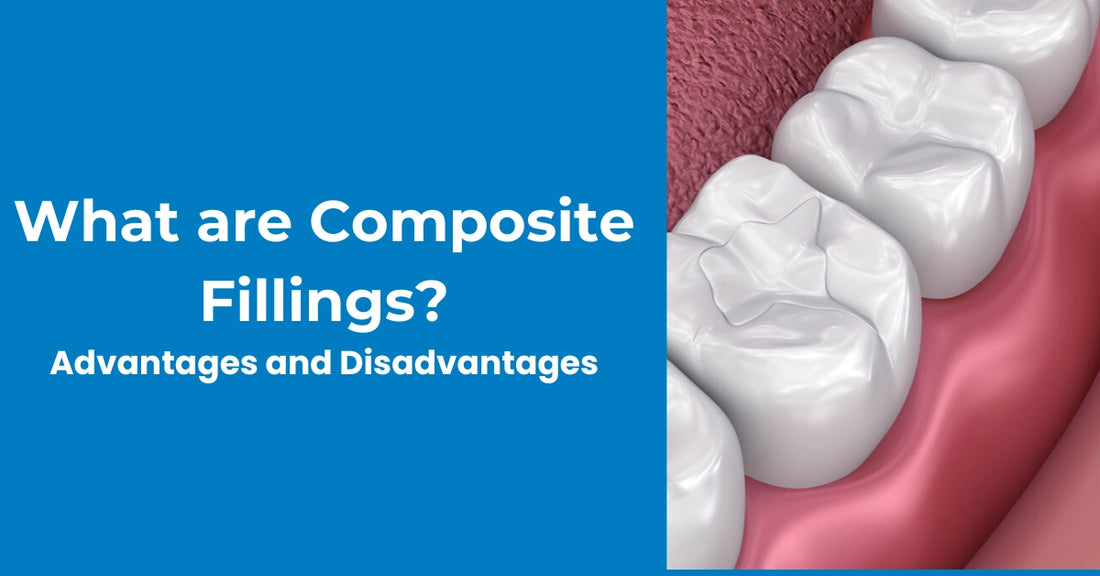Composite fillings, composed of plastic and glass particles, represent a breakthrough in dental care. These fillings seamlessly repair cavities, offering a discreet solution that mirrors the natural color and texture of teeth. Particularly their application in visible areas, such as composite filling for front teeth, where aesthetics play a pivotal role. As an innovative alternative to traditional silver amalgam, composite fillings provide a versatile approach to dental restoration. In this study, we will learn about composite filling, delving into their advantages and disadvantages. We will explore a comprehensive understanding of their impact on oral health. Let's dive in:
What is a Composite Filling?
Composite fillings, also known as tooth-colored or white fillings. They are a dental product designed to repair cavities, cracks, or fractures in teeth. These fillings is a dental restoration material used to repair teeth that have been affected by decay, fractures, or cavities. Composed of plastic (resin) and fine glass particles, composite filling usually matches with tooth-color or white fillings. Unlike traditional silver amalgam fillings, composites closely blends the natural color and texture of teeth. It makes them a popular choice for visible areas, including front teeth.
The composite filling process involves the removal of the damaged or decayed part of the tooth. Followed by the application of the composite material in layers these fillings provides durability to teeth. Each layer is cured or hardened using a special light. This layering technique allows for precise shaping and ensures a strong bond with the tooth.
Advantages of Composite Fillings:
-
Aesthetically Pleasing
One of the primary advantages of composite filling is its ability to seamlessly blend with the natural color of your teeth. Unlike traditional silver amalgam fillings, composite fillings offer a discreet solution, making them an ideal choice for visible areas, such as composite filling for front teeth. These fillings not only restore dental health but also contribute to a confident smile. The inconspicuous nature of these fillings allows individuals to maintain a natural and aesthetically pleasing appearance, boosting self-esteem and overall well-being.
-
Versatility in Application
Composite fillings are incredibly versatile and can be used for various dental issues, including repairing cavities, cracks, or even reshaping teeth for cosmetic reasons. The composite resin can be precisely color-matched, ensuring a seamless integration with the existing tooth structure. Also, their versatility extends beyond functionality to artistic applications, allowing for the creation of intricate shapes and contours. Whether it's a minor correction or a major restoration, composite fillings provide a customizable and versatile solution for diverse dental needs.
-
Conservative Tooth Preparation
Unlike amalgam fillings, composite fillings require less removal of healthy tooth structure during the preparation phase. This conservative approach helps preserve more of the natural tooth, contributing to its overall strength. Preserving healthy tooth structure not only enhances the longevity of the tooth but also minimizes the risk of potential complications. The conservative tooth preparation technique employed with composite filling aligns with the principles of maintaining optimal dental health.
-
Reduced Sensitivity to Temperature Changes
Composite fillings demonstrate a superior ability to insulate teeth from temperature changes. This feature helps reduce post-treatment sensitivity, a common concern with other filling materials. The advanced insulation properties of composite filling not only ensure comfort during daily activities but also diminish the likelihood of discomfort often associated with consuming hot or cold foods. This reduction in sensitivity adds to the overall positive experience for individuals with these fillings.
-
Adhesive Bonding for Enhanced Support
The bonding process involved in placing composite fillings allows for a strong and durable connection with the tooth. This adhesive bonding enhances the overall support and longevity of the restoration. The secure bond formed between the composite filling and the natural tooth creates a resilient foundation. Moreover, this enhanced support not only ensures the longevity of the restoration but also contributes to the overall stability and functionality of the treated tooth.
Disadvantages of Composite Fillings:
-
Cost Considerations
While composite fillings offer numerous benefits, they tend to be more expensive than traditional amalgam fillings. The cost may be a deciding factor for individuals without dental insurance coverage. It's essential to weigh the long-term value against the immediate cost, considering the aesthetic and conservative advantages composite filling provides.
-
Susceptibility to Staining
Composite fillings are more prone to staining over time compared to other materials. Factors such as frequent consumption of coffee, tea, or tobacco can impact the appearance of the filling. Regular dental hygiene practices and reduced consumption of stain-inducing substances can help mitigate staining concerns associated with composite filling.
-
Durability Concerns for Posterior Composite Fillings
In posterior teeth that endure more significant biting forces, composite filling may not be as durable as amalgam alternatives. This can result in a shorter lifespan for fillings in these areas. Discussing with your dentist about alternative materials for posterior teeth may be prudent, ensuring longevity and effectiveness in areas with heightened chewing pressures.
-
Technique Sensitivity
Proper placement of composite fillings requires a high level of skill and precision. The technique sensitivity involved can influence the success and longevity of the restoration. Seeking an experienced dentist familiar with advanced placement techniques enhances the likelihood of a successful and enduring composite filling.
Conclusion
In summary, composite filling represent a cutting-edge solution in modern dentistry, offering aesthetic appeal and versatility. As with any dental procedure, it's essential to weigh the advantages and disadvantages to make an informed decision. Whether you opt for composite fillings for front teeth or posterior fillings, understanding the nuances of this dental product will empower you to navigate your oral health journey with confidence. Embrace the progress in dental technology, and consult with your dentist to determine the best course of action for your unique needs.

